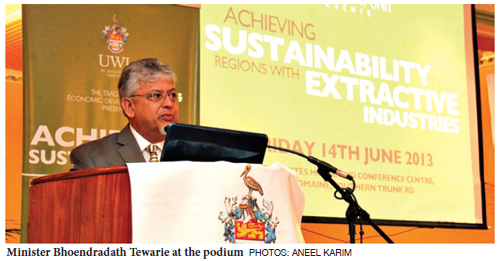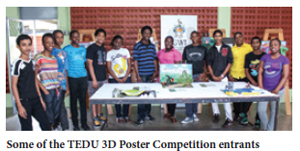 |
 |
 |
|
July 2013
|
The tightly packed conference was part of a larger local economic development initiative jointly funded by Atlantic and the Inter-American Development Bank, in partnership with TEDU and the Point Fortin Borough Corporation. The aim is to enhance sustainable development options for persons and communities in the southwest peninsula of Trinidad, where oil and gas extraction dominate industrial activity. Dr Bhoendradatt Tewarie, Minister of Planning and Sustainable Development, opened the conference and the innings. He set the context of a southwest peninsula that is targeted as a growth pole for an energy industry, with 12 major oil and gas players, which contributes half of the country’s GDP. The devolution of power to the two regional corporations – Point Fortin and Siparia – is meant to complement the development process. TEDU Coordinator Dr Roger Hosein and Central Bank’s Dr Alvin Hilaire situated the conference’s examination of development opportunities against a background of macroeconomics of countries with extractive industries (EI). Both presenters underscored trends such as Dutch disease and rent-seeking activity, typical of countries dependent on revenues from extractive industries. ‘Dutch disease’ refers to the negative consequences arising from large increases in a country’s income and is primarily associated with a natural resource discovery. ‘Rent seeking’ relates to the use of resources for an economic gain without reciprocating any benefits to society through wealth creation. Dr Hosein examined effects such as de-agriculturisation, lower productivity in the manufacturing sector, increased levels of pollution and inefficiencies in government spending and social programmes. He proposed solutions such as harmonising local economic development strategies with growth pole policy, tapping into the diaspora to provide development funds and re-emphasising the CARICOM market. Revenue from taxation of these industries allowed governments to undertake large projects, to invest and save. Dr. Hilaire cited the Heritage and Stabilisation Fund as one example of savings. Macroeconomic challenges to the local economy are not just external but also internal, such as political economic decisions and answers to questions such as, who owns extractive industry wealth, the rate at which extraction should proceed and who should benefit from these finite resources. He considered Trinidad & Tobago’s experience of two energy-related booms – the most recent ending in 2008 – during which surpluses were accumulated. Conference presenters examined the interests and opportunities for meaningful participation of all major stakeholders impacted by EIs. These include civil society, EI industry professionals and companies and multi-stakeholder partnerships - the private sector, government and civil society, small and medium-sized enterprises. The need to forge effective links among government, extractive industry companies and local communities emerged as a continuous thread. Structured opportunities for multi-stakeholder partnerships are available at the international and national levels. On the international front, Mark Regis of the Trinidad & Tobago Extractive Industries Transparency Initiative outlined milestones in moving from candidate country to compliant country status with regard to this global partnership. Civil society, government and business are on the steering committee guiding this process. Dr Thackwray Driver presented case studies of a local industry association’s innovation in the creation of standards via the Energy Chamber’s STOW – Safe to Work - standard. He underscored that standards are aimed at facilitating economic development and, as such, the Energy Chamber had worked with the National Training Agency to create a competency assurance system which addresses EI companies’ interest in having a competent workforce. Lennox Sirjuesingh, president of the Local Content Chamber, emphasised local capacity and competence as significant for creating jobs and possibly replacing state expenditure in social spending and poverty reduction. Dr Ron Sookram and Sharon Bradshaw’s presentations addressed the question of civil society’s role as an active participant in the management of EIs and, more broadly, in influencing the enhanced quality of life which EI revenues can facilitate for host communities and countries. Civil society organisations – social movements, trade unions and other non-governmental organisations – may have challenges of capacity to undertake an informed and sustained role. Bradshaw proposed that civil society build their knowledge of the EI sector, develop institutional frameworks for collaboration among themselves and in so doing seek support for both processes. Gillian Friday shared the corporate social responsibility of Petrotrin, a national EI company. Its basis for engagement echoed previous themes with its emphasis on local content, the imperative for balancing development inequalities among regions where EI corporations are located, and transparency. Friday’s presentation disclosed levels of revenue earned by the company as well as levels of taxes paid to government over a period ending 2011. Kizzan Lee Sam of the Caribbean Local Economic Development (LED) Programme identified links among extractive industries, LED strategies in regions with EIs and opportunities for small business development in those regions. Business training, networking, mentoring and research analysis which identifies opportunities and facilitates local procurement are all critically needed support areas for small and medium enterprises. She advocated clustering SMEs in the CARICOM region to more effectively develop resources and access markets. Sustainable Development in 3D
Five schools in the south west peninsula were targeted, with only two responding to the challenge. Point Fortin East Secondary entered four teams; while Vessigny High School had three. A Point Fortin team emerged the winner, capturing the highest points in all these categories.
|


 UWI’s Trade and Economic Unit (TEDU) of the Department of Economics posed it as a statement, rather than a question: Achieving Sustainability in Regions with Extractive Industries. However, participants at a conference dealing with the issue saw it as a ‘how to’ and a real dilemma.
UWI’s Trade and Economic Unit (TEDU) of the Department of Economics posed it as a statement, rather than a question: Achieving Sustainability in Regions with Extractive Industries. However, participants at a conference dealing with the issue saw it as a ‘how to’ and a real dilemma. A 3D poster competition sought to allow students to explore the link between the extractive industries and sustainable development, by discussing what sustainable development means to their communities. Team entrants had to include the statement “Sustainability – The Way Forward” along with three 3D components. The bases for judging were overall impact, concept, originality, innovative design, craftsmanship, execution, completeness of work and the use of materials tied to extractive industries.
A 3D poster competition sought to allow students to explore the link between the extractive industries and sustainable development, by discussing what sustainable development means to their communities. Team entrants had to include the statement “Sustainability – The Way Forward” along with three 3D components. The bases for judging were overall impact, concept, originality, innovative design, craftsmanship, execution, completeness of work and the use of materials tied to extractive industries.